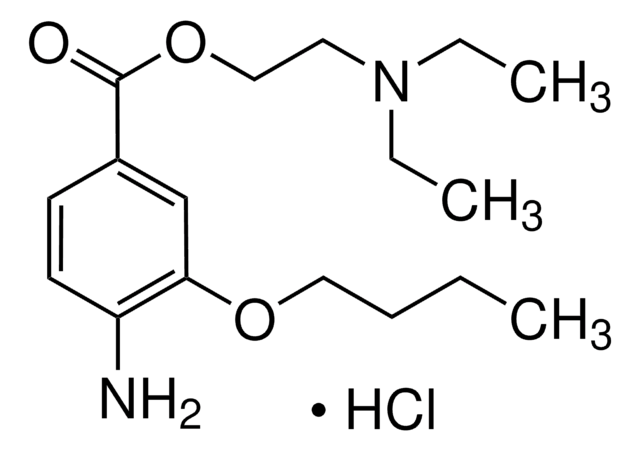B9050
Benoxinate hydrochloride
meets USP testing specifications
Synonym(s):
2-(Diethylamino)ethyl 4-amino-3-butoxybenzoate hydrochloride, 4-Amino-3-butoxybenzoic acid diethylaminoethyl ester, Oxybuprocaine hydrochloride
About This Item
Recommended Products
Agency
USP/NF
meets USP testing specifications
Quality Level
form
solid
application(s)
pharmaceutical (small molecule)
SMILES string
Cl[H].CCCCOc1cc(ccc1N)C(=O)OCCN(CC)CC
InChI
1S/C17H28N2O3.ClH/c1-4-7-11-21-16-13-14(8-9-15(16)18)17(20)22-12-10-19(5-2)6-3;/h8-9,13H,4-7,10-12,18H2,1-3H3;1H
InChI key
PRGUDWLMFLCODA-UHFFFAOYSA-N
Gene Information
human ... SCN10A(6336) , SCN11A(11280) , SCN1A(6323) , SCN2A(6326) , SCN3A(6328) , SCN4A(6329) , SCN5A(6331) , SCN7A(6332) , SCN8A(6334) , SCN9A(6335)
Looking for similar products? Visit Product Comparison Guide
Storage Class Code
13 - Non Combustible Solids
WGK
WGK 3
Flash Point(F)
Not applicable
Flash Point(C)
Not applicable
Personal Protective Equipment
Choose from one of the most recent versions:
Already Own This Product?
Find documentation for the products that you have recently purchased in the Document Library.
Our team of scientists has experience in all areas of research including Life Science, Material Science, Chemical Synthesis, Chromatography, Analytical and many others.
Contact Technical Service






